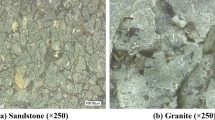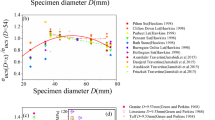Abstract
Effects of orientation, number of sets, and frequency of discontinuities on the rock strength under triaxial stresses have been investigated by the empirical method in this research. Twenty groups of rock specimens including intact rock, rock specimens having one, two, or three sets of discontinuities with various frequencies and orientations of 0°, 30°, 45°, 60°, and 90° have been prepared and tested under triaxial compressive stresses. The axial strength of each group has been tested under confining pressure of 0, 5, 7, 10, 14, and 20 MPa. Axial specimen strength, having one set of discontinuity, decreases a little with increase of the orientation angle from 0° to 30° under the most confining pressures; the relationship between axial strength and orientation angle between 30° and 90° has a shoulder shape under low values of confining pressures. The shoulder shape relationship also changes with increase of the confining pressure as it disappears at high values of confining pressures. The shoulder shape range of reduction axial strength under confining pressures due to the orientation of discontinuities changes similar to a twin symmetrical shoulder shape for specimens having two or more perpendicular sets of discontinuities as another minimum axial strength occurs at orientation angle of 30° on the opposite direction as well as orientation of 60°. The uniaxial compressive strength approaches approximate zero value at orientation angle of 60° for specimens having different sets and frequencies of discontinuities and it also approaches to zero at orientation angle of 30° for specimens having two or more sets of discontinuities; axial strength has considerable value under triaxial stresses. Effects of three parameters of orientation, frequency, and number of sets of discontinuities on the axial strength decreases with increase of confining pressure as minimum and maximum values of the axial strengths of specimens are between 74 and 100 % of the axial strength of intact rock under confining pressure greater than or equal to 10 MPa in this research.















Similar content being viewed by others
References
Arora V K (1987) Strength and deformational behavior of jointed rocks. Ph.D thesis Indian Institute of Technology, Delhi, India
ASTM (1997) Standard test method for triaxial compressive strength of undrained rock core specimens without pore pressure measurements. ASTM Annual Book of Standards, D2664-95a, pp 242–245
Chong WL, Haque A, Gamage RP, Shahinuzzaman A (2013) Modelling of intact and jointed mudstone samples under uniaxial and triaxial compression. Arab J Geosci 6:1639–1646
Coulomb C A (1776) Essai sur une application des régels de maximis et minimis quelque problémes de statique, relatifs. l'architecture, Mémoires de Mathamatique et de Physique, L’Academie Royale des Sciences, vol 7, pp 343–382
FLAC3D (1997) FLAC3D, Fast Lagrangian analysis of continua in three dimensions. Manual. Itasca Consulting Group, Minneapolis, MN, USA
Ghazvinian A, Azinfar MJ, Norozi P (2012) Mechanical response of discontinuities of different joint wall contact strengths. Arab J Geosci. doi:10.1007/s12517-012-0683-6
Hoek E, Franklin JA (1968) Simple triaxial cell for field or laboratory testing of rock. Trans Inst Min Metal Vol 77:A22–A26
ISRM (1981) Suggested methods for determination of direct shear strength. Rock characterization testing and monitoring. In: Brown, ET (ed). Pergamon Press: New York. pp 135–137
Jaeger JC (1960) Shear failure of anisotropic rock. Geol Mag Vol 1:65–72
Karaku H, Ulusay R, Isik NS (2010) Empirical models and numerical analysis for assessing strength anisotropy based on block punch index and uniaxial compression tests. Int J Rock Mech Min Sci 47:657–665
Lama R D (1974) The uniaxial compressive strength of jointed rock. In: Muller L Festschrift (ed). Institute of Soil Mechanics and Rock Mechanics, University of Karlsruhe, Karlsruhe. pp. 67–77.
Ma K, Tang CA, Li LC, Ranjith PG, Cai M, Xu NW (2013) 3D modeling of stratified and irregularly jointed rock slope and its progressive failure. Arab J Geosci 6:2147–2163
Mohr O (1900) Welche Umstände bdeingen die Elatizitätsgrenze und den Bruch eines. Materiales, Z Verei, Dtsch Ing vol. 44, pp 1524–1530; 1572–1577
Ramamurthy T, Arora VK (1994) Strength predictions for jointed rocks in confined and unconfined states. Int J Rock Mech Min Sci 31(1):9–22
Ramamurthy T (2001) Shear strength response of some geological materials in triaxial compression. Int J Rock Mech Min 38:683–697
Singh M, Rao KS, Ramamurthy T (2002) Strength and deformational behavior of a jointed rock mass. Rock Mech Rock Eng 35(1):45–64
Sitharam TG, Maji VB, Verma AK (2007) Practical equivalent continuum model for simulation of jointed rock mass using FLAC-3D. Int J Geomech 7(5):389–395
Tang CA, Tham LG, Lee PKK, Tsui Y, Liu H (2000) Numerical studies of the influence of microstructure on rock failure in uniaxial compression—part II: constraint, slenderness and size effect. Int J Rock Mech Min Sci 37:571–583
Verma AK, Singh TN (2010) Modeling of a jointed rock mass under triaxial conditions. Arab J Geosci 3:91–103
Acknowledgments
I like to express my sincere thanks to Mr M. R. Saei B.Sc, Technical Officer of Mining Engineering for his invaluable assistance in perpetration and testing the jointed rock specimens at Rock Mechanics Laboratory of Urmia University.
Author information
Authors and Affiliations
Corresponding author
Rights and permissions
About this article
Cite this article
Moomivand, H. Effects of orientation, frequency, and number of sets of discontinuities on rock strength under triaxial stresses. Arab J Geosci 7, 5345–5352 (2014). https://doi.org/10.1007/s12517-013-1069-0
Received:
Accepted:
Published:
Issue Date:
DOI: https://doi.org/10.1007/s12517-013-1069-0




